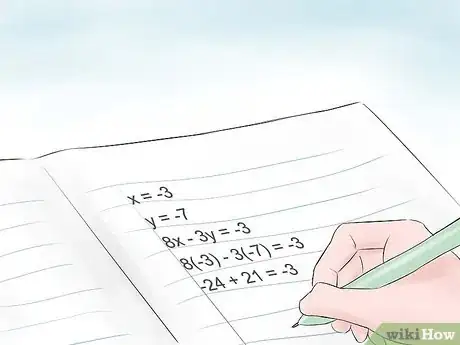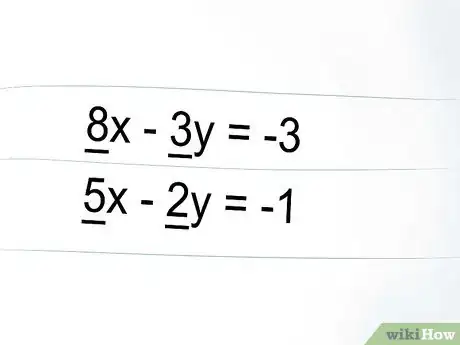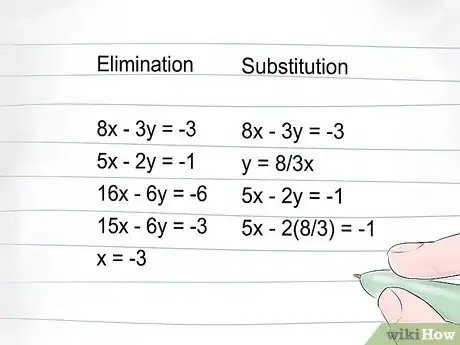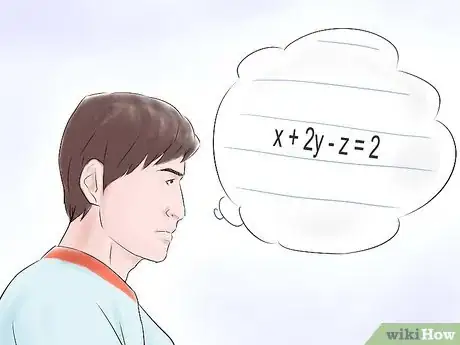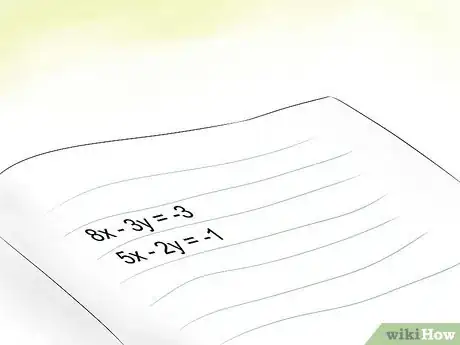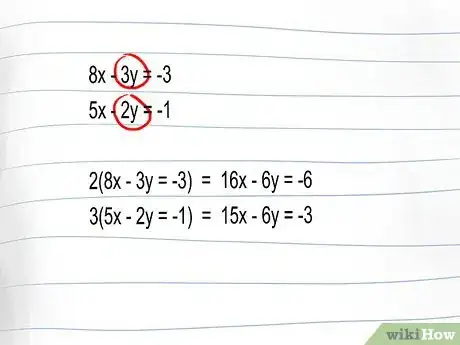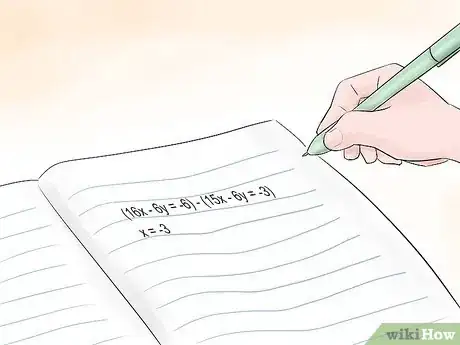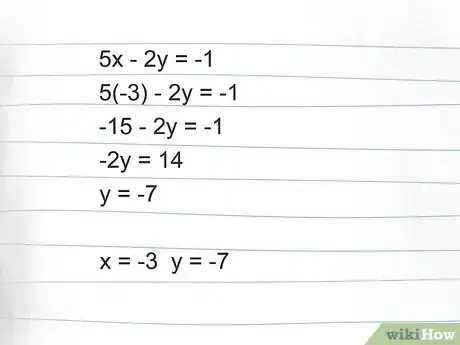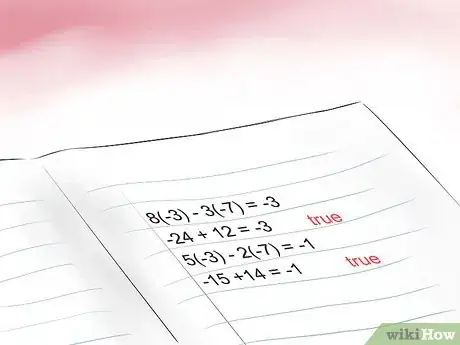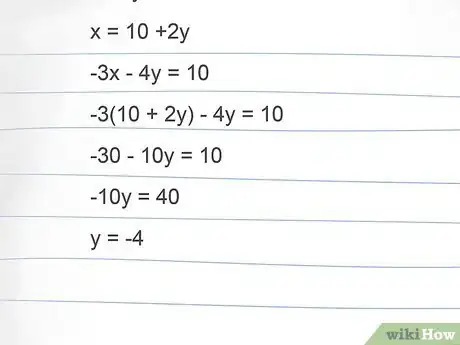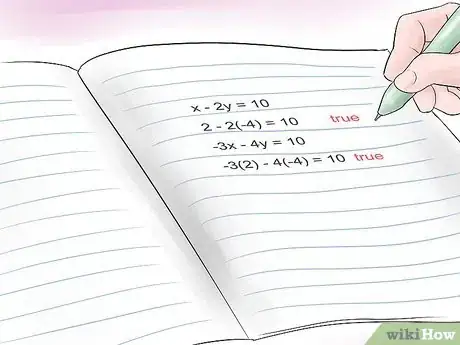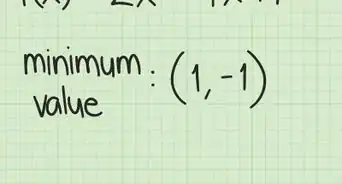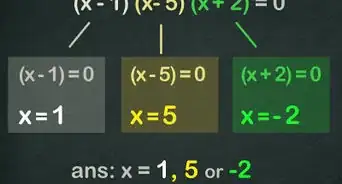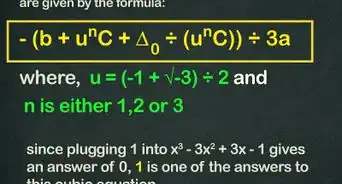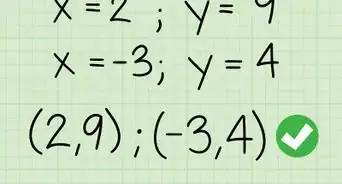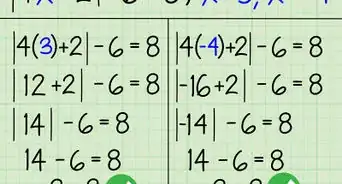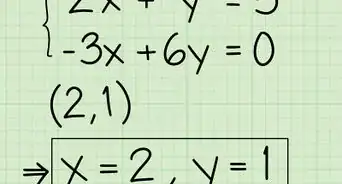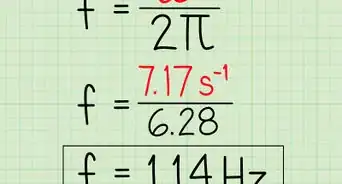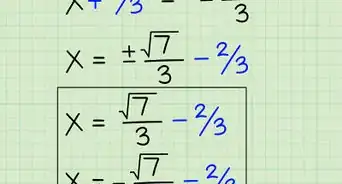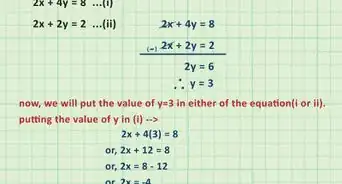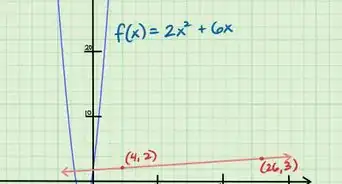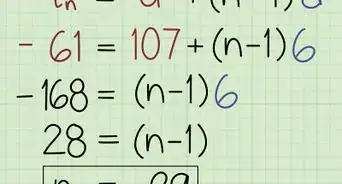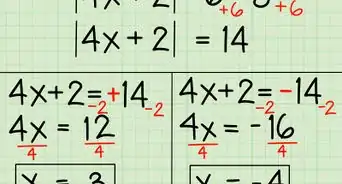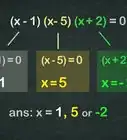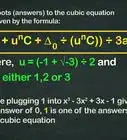X
wikiHow is a “wiki,” similar to Wikipedia, which means that many of our articles are co-written by multiple authors. To create this article, volunteer authors worked to edit and improve it over time.
This article has been viewed 86,372 times.
Learn more...
Multivariable linear equations are equations that have two or more unknowns (generally represented by 'x' and 'y'). There are multiple ways that you can solve these equations, including elimination and substitution.
Steps
Method 1
Method 1 of 3:
Understanding the Components of Linear Equations
-
1Understand what multi-variable equations are. Two or more linear equations that are grouped together are called a system. That means that a system of linear equations is when two or more linear equations are being solved at the same time.[1] For example:
- 8x - 3y = -3
- 5x - 2y = -1
- These are two linear equations that you must solve at the same time, meaning you must use both equations to solve both equations.
-
2Know that you are trying to figure out the values of the variables, or unknowns. The answer to the linear equations problem is an ordered pair of numbers that make both of the equations true.[2]
- In the case of our example, you are trying to find out what numbers ‘x’ and ‘y’ represent that will make both of the equations true. In the case of this example, x = -3 and y = -7. Plug them in. 8(-3) - 3(-7) = -3. This is TRUE. 5(-3) -2(-7) = -1. This is also TRUE.
Advertisement -
3Know what a numerical coefficient is. The numerical coefficient is simply the number that comes before a variable.[3] You will use these numerical coefficients when using the elimination method. In our example equations, the numerical coefficients are:
- 8 and 3 for the first equation; 5 and 2 for the second equation.
-
4Understand the difference between solving with elimination and solving with substitution. When you use elimination to solve a multivariable linear equation, you get rid of one of the variables you are working with (such as ‘x’) so that you can solve the other variable (‘y’). Once you find ‘y’, you can plug it into the equation and solve for ‘x’ (don’t worry, this will be covered in detail in Method 2).[4]
- Substitution, on the other hand, is where you begin working with only one equation so that you can again solve for one variable. Once you solve one equation, you can plug in your findings to the other equation, effectively making one large equation out of your two smaller ones. Again, don’t worry—this will be covered in detail in Method 3.
-
5Understand that there can be linear equations that have three or more variables. Solving for three variables can actually be done in the same way that equations with two variables are solved. You can use elimination and substitution, they will just take a little longer than solving for two, but are the same process.
Advertisement
Method 2
Method 2 of 3:
Solving a Linear Equation with Elimination
-
1Look at your equation. In order to solve the problem, you will need to familiarize yourself with the components of the equations. Let’s use the following example to learn how to eliminate variables:
- 8x - 3y = -3
- 5x - 2y = -1
-
2Choose a variable to eliminate. To eliminate a variable, the numerical coefficient (the number in front of the variable) of a variable must be opposite to one another (for instance 5 and -5 are opposites). The goal is to get rid of one variable, so that you can solve for the other variable by eliminating one through subtraction. This means making the coefficients of the same variable in both equations cancel each other out.[5] For instance:
- In 8x - 3y = -3 (equation A) and 5x - 2y = -1 (equation B), you can multiply equation A with 2 and equation B with 3 so that you get 6y in equation A and 6y in equation B.
- This would look like: equation A: 2(8x - 3y =-3) = 16x -6y = -6.
- Equation B: 3(5x - 2y = -1) = 15x -6y =-3
-
3Add or subtract the two equations to remove one of the variables and solve the other variable. Now that you have a variable that can be eliminated, you can do so by adding or subtracting. Whether you add or subtract will depend on how you will be able to remove the variable. In our equation we would subtract, because 6y is in each of the equations:[6]
- (16x - 6y = -6) - (15x - 6y = -3) = 1x = -3. Therefore x = -3.
- For other cases, if the numerical coefficient of x is not 1 after we add or subtract, we must divide both sides by the numerical coefficient to simplify the equation.
-
4Plug in your solution to solve for the remaining variable. Now that you have found what ‘x’ equals, you can plug that number into one of the original equations to solve for ‘y’.[7] When you know that it works in one of the equations, you can try plugging it into the other equation to make sure:
- Equation B: 5(-3) - 2y = -1 so -15 -2y = -1. Add 15 to both sides so -2y = 14. Divide both sides by -2 so that y = -7.
- Therefore x = -3 and y = -7.
-
5Plug your findings into both equations to make sure that they are correct. Once you have found your variables, plug them into the original equations to make sure they are correct. If one of the equations doesn’t work with the variables you have found, you will have to try again.
- 8(-3) - 3(-7) = -3 so -24 +21 = -3 TRUE.
- 5(-3) -2(-7) = -1 so -15 + 14 = -1 TRUE.
- Therefore, the variables we have found are correct.
Advertisement
Method 3
Method 3 of 3:
Solving a Linear Equation with Substitution
-
1Begin by solving one equation for either variable. It doesn’t matter which equation you decide to work with or even which variable you choose to solve for, as you should find the same solution no matter what. However, you do want to make the process as simple as possible. You should choose the equation that you think will be easiest to work with.[8] For instance, if there is an equation where one of the coefficients is 1, such as x - 3y = 7, you would choose that as it will be easy to solve for ‘x’. For example, let’s say our equations are:
- x - 2y = 10 (equation A) and -3x -4y = 10 (equation B). You would choose to work with x - 2y = 10 because the coefficient of x in this equation is 1.
- Solving for x in equation A would meaning adding 2y to both sides. Therefore, x = 10 + 2y.
-
2Substitute your findings in Step 1 into the other equation. For this step, you will need to insert (or substitute) your solution for ‘x’ into the other solution that you did not work with. This will allow you to find the other variable, in this case ‘y’.[9] Let’s try it:
- Insert the ‘x’ of equation B into equation A: -3(10 + 2y) -4y = 10. You can see that we have taken ‘x’ out of the equation and inserted what ‘x’ equals.
-
3Solve for the other variable. Now that you have removed one of the variables from the equation, you can solve for the other variable. This is is simply solving a regular one-variable linear equation.[10] Let’s solve ours:
- -3(10 + 2y) -4y = 10 so -30 -6y -4y = 10.
- Combine the y’s: -30 - 10y = 10.
- Move the -30 over to the other side: -10y = 40.
- Solve for y: y = -4.
-
4Solve the second variable. To do this, plug your findings for ‘y’, or the first variable, into one of the equations.[11] Then solve for the other variable, in this case ‘x’. Let’s try it:
- Solve for ‘x’ in equation A by plugging in y = -4: x - 2(-4) = 10.
- Simply the equation: x + 8 = 10.
- Solve for x: x = 2.
-
5Double check that the variables you have found work for both equations. Plug both of the variables into each equation to make sure that they create true equations.[12] Let’s see if ours work:
- Equation A: 2 - 2(-4) = 10 is TRUE.
- Equation B: -3(2) -4(-4) = 10 is TRUE.
Advertisement
Community Q&A
-
QuestionCan I solve a linear equation with 12 variables?
 DonaganTop AnswererIn order to find the values of 12 variables, you would need to be provided a system of at least 12 equations, each expressed in some of those variables.
DonaganTop AnswererIn order to find the values of 12 variables, you would need to be provided a system of at least 12 equations, each expressed in some of those variables. -
QuestionHow do I solve an equation with three variables?
 DonaganTop AnswererYou must have three independent equations in the same three variables in order to solve for those variables.
DonaganTop AnswererYou must have three independent equations in the same three variables in order to solve for those variables.
Advertisement
References
- ↑ Steward, J., Lothar, R., Watson, S., Algebra and Trigonometry. Second Edition. Singapore: Thomson Learning Asia,
- ↑ https://www.khanacademy.org/test-prep/praxis-math/praxis-math-lessons/praxis-math-algebra/a/gtp--praxis-math--article--linear-equations--lesson
- ↑ http://www.wtamu.edu/academic/anns/mps/math/mathlab/col_algebra/col_alg_tut49_systwo.htm
- ↑ https://people.richland.edu/james/lecture/m116/systems/gaussian.html
- ↑ Steward, J., Lothar, R., Watson, S., Algebra and Trigonometry. Second Edition. Singapore: Thomson Learning Asia,
- ↑ https://people.richland.edu/james/lecture/m116/systems/gaussian.html
- ↑ http://www.wtamu.edu/academic/anns/mps/math/mathlab/col_algebra/col_alg_tut49_systwo.htm
- ↑ http://www.wtamu.edu/academic/anns/mps/math/mathlab/col_algebra/col_alg_tut49_systwo.htm
- ↑ Steward, J., Lothar, R., Watson, S., Algebra and Trigonometry. Second Edition. Singapore: Thomson Learning Asia,
- ↑ https://www.mathplanet.com/education/algebra-1/systems-of-linear-equations-and-inequalities/the-substitution-method-for-solving-linear-systems
- ↑ https://www.mathplanet.com/education/algebra-1/systems-of-linear-equations-and-inequalities/the-substitution-method-for-solving-linear-systems
- ↑ https://www.purplemath.com/modules/systlin4.htm
About This Article
Advertisement

